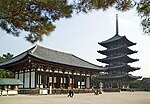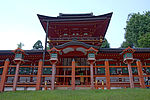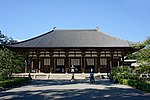
Tōdai-ji is a Buddhist temple complex that was once one of the powerful Seven Great Temples, located in the city of Nara, Japan. Though it was originally founded in the year 738 CE, Todai-ji was not opened until the year 752 CE. Its Great Buddha Hall houses the world's largest bronze statue of the Buddha Vairocana, known in Japanese as Daibutsu (大仏). The temple also serves as the Japanese headquarters of the Kegon school of Buddhism. The temple is a listed UNESCO World Heritage Site as one of the "Historic Monuments of Ancient Nara", together with seven other sites including temples, shrines and places in the city of Nara.

Gangō-ji (元興寺) is an ancient Buddhist temple, that was once one of the powerful Seven Great Temples, in Nara, Japan.

Tōshōdai-ji (唐招提寺) is a Buddhist temple of the Risshū sect in the city of Nara, in Nara Prefecture, Japan. The Classic Golden Hall, also known as the kondō, has a single story, hipped tiled roof with a seven bay wide facade. It is considered the archetype of "classical style."

Kasuga Grand Shrine is a Shinto shrine in Nara, Nara Prefecture, Japan. It is the shrine of the Fujiwara family, established in 768 CE and rebuilt several times over the centuries. The interior is famous for its many bronze lanterns, as well as the many stone lanterns that lead up the shrine.

A National Treasure is the most precious of Japan's Tangible Cultural Properties, as determined and designated by the Agency for Cultural Affairs. A Tangible Cultural Property is considered to be of historic or artistic value, classified either as "buildings and structures" or as "fine arts and crafts." Each National Treasure must show outstanding workmanship, a high value for world cultural history, or exceptional value for scholarship.

The Ujigami Shrine is a Shinto shrine in the city of Uji, Kyoto Prefecture, Japan. The shrine was built as a guardian shrine for the nearby Byōdō-in, and is adjacent to the Uji Shrine. In 1994, it was registered as a UNESCO World Heritage Site as one of the "Historic Monuments of Ancient Kyoto". The honden and haiden have been designated by the Agency for Cultural Affairs as National Treasures in the category shrines.

Hokki-ji or Hōki-ji – formerly known as Okamoto-dera (岡本寺) and Ikejiri-dera (池後寺) – is a Buddhist temple in Okamoto, Ikaruga, Nara Prefecture, Japan. The temple's honorary sangō prefix is "Kōhonzan" (岡本山), although it is rarely used. The temple was constructed to honor Avalokitesvara, and an 11-faced statue of the goddess is the primary object of worship in the temple. Hokki-ji is often considered to be one of the seven great temples founded by Prince Shōtoku, but in fact the temple was not completed until some decades after his death. In 1993, it was registered together with Hōryū-ji as an UNESCO World Heritage Site under the name Buddhist Monuments in the Hōryū-ji Area.

Nara is the capital city of Nara Prefecture, Japan.

Mount Misen is the sacred mountain on Itsukushima in Hatsukaichi, Hiroshima, Japan, and is the highest mountain on the island at 535 m; it is situated within the World Heritage area of Itsukushima Shrine.
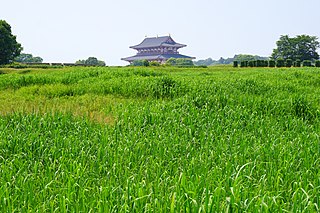
Heijō-kyō, was the Capital of Japan during most of the Nara period, from 710–40 and again from 745–84. The imperial palace is a listed UNESCO World Heritage together with other places in the city of Nara.

Rinnō-ji (輪王寺) is a Tendai Buddhist temple buildings in the city of Nikkō, Tochigi Prefecture, Japan.

The UNESCO World Heritage Site Historic Monuments of Ancient Kyoto encompasses 17 locations in Japan within the city of Kyoto and its immediate vicinity. The locations are in three cities: Kyoto and Uji in Kyoto Prefecture; and Ōtsu in Shiga Prefecture; Uji and Ōtsu border Kyoto to the south and north, respectively. Of the monuments, 13 are Buddhist temples, three are Shinto shrines, and one is a castle. The properties include 38 buildings designated by the Japanese government as National Treasures, 160 properties designated as Important Cultural Properties, eight gardens designated as Special Places of Scenic Beauty, and four designated as Places of Scenic Beauty. UNESCO listed the site as World Heritage in 1994.

The UNESCO World Heritage Site Shrines and Temples of Nikkō encompasses 103 buildings or structures and the natural setting around them. It is located in Nikkō, Tochigi Prefecture, Japan. The buildings belong to two Shinto shrines and one Buddhist temple (Rinnō-ji). Nine of the structures are designated National Treasures of Japan while the remaining 94 are Important Cultural Properties. UNESCO listed the site as World Heritage in 1999.

The UNESCO World Heritage Site Buddhist Monuments in the Hōryū-ji Area includes a variety of buildings found in Hōryū-ji and Hokki-ji in Ikaruga, Nara Prefecture, Japan. These buildings were designated in 1993 along with the surrounding landscape, under several criteria. The structures inscribed are some of the oldest extant wooden buildings in the world, dating from the 7th to 8th centuries. Many of the monuments are also National Treasures of Japan, and reflect an important age of Buddhist influence in Japan. The structures include 21 buildings in the Hōryū-ji East Temple, 9 in the West Temple, 17 monasteries and other buildings, and the pagoda in Hokki-ji.

A Cultural Property is administered by the Japanese government's Agency for Cultural Affairs, and includes tangible properties ; intangible properties ; folk properties both tangible and intangible; monuments historic, scenic and natural; cultural landscapes; and groups of traditional buildings. Buried properties and conservation techniques are also protected. Together these cultural properties are to be preserved and utilized as the heritage of the Japanese people.
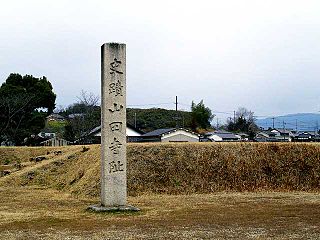
Yamada-dera (山田寺) was a Buddhist temple established in the Asuka period in Sakurai, Nara Prefecture, Japan. The area has been designated a Special Historic Site and forms part of a grouping of sites submitted in 2007 for future inscription on the UNESCO World Heritage List: Asuka-Fujiwara: Archaeological sites of Japan’s Ancient Capitals and Related Properties. Excavations in the 1980s uncovered a well-preserved section of the temple's covered corridors that predate the surviving buildings of Hōryū-ji: "for the history of Japanese architecture, this discovery is of as great moment as the finding of the seventh-century Takamatsuzuka tomb paintings in March 1972 was for the history of Japanese art."


